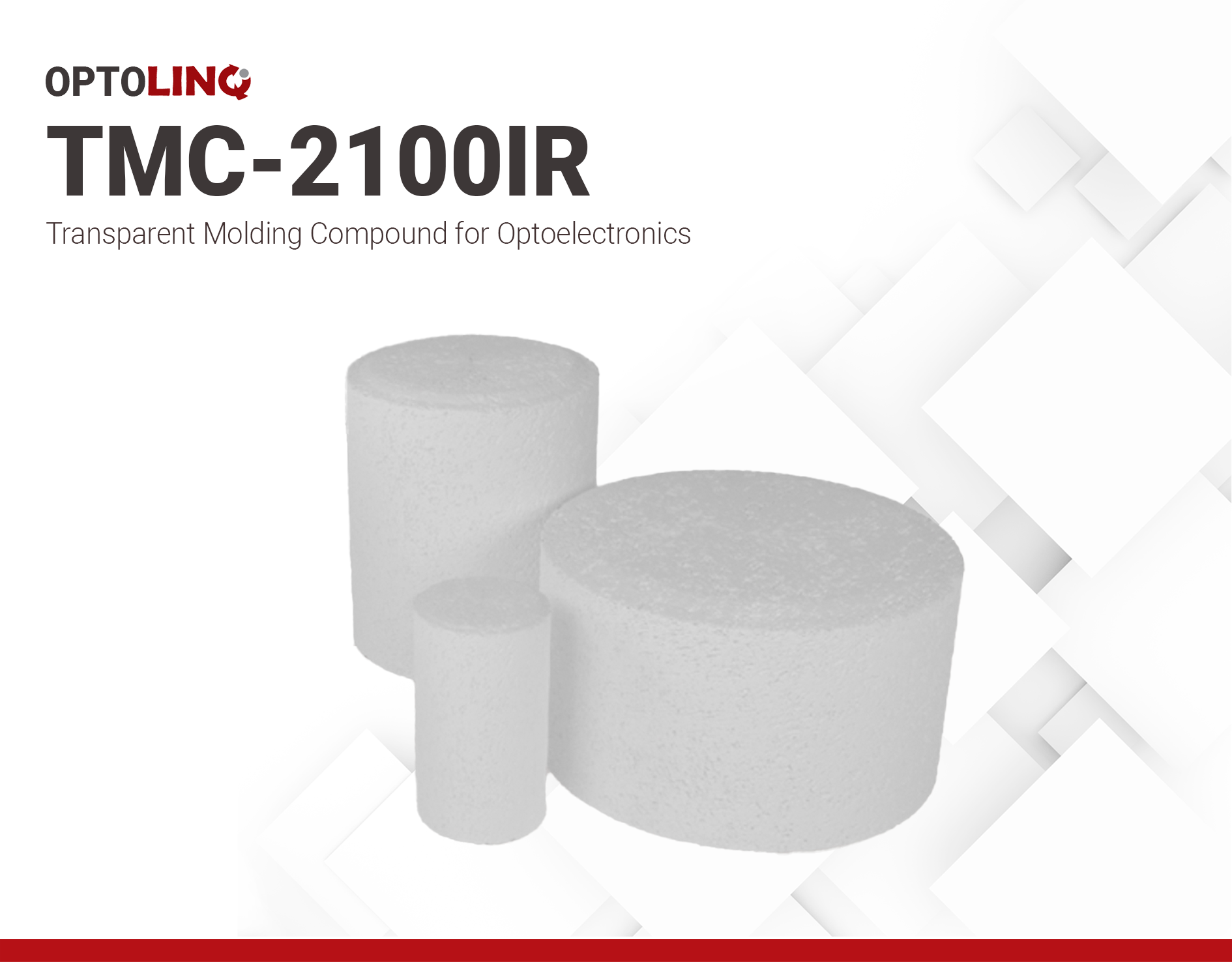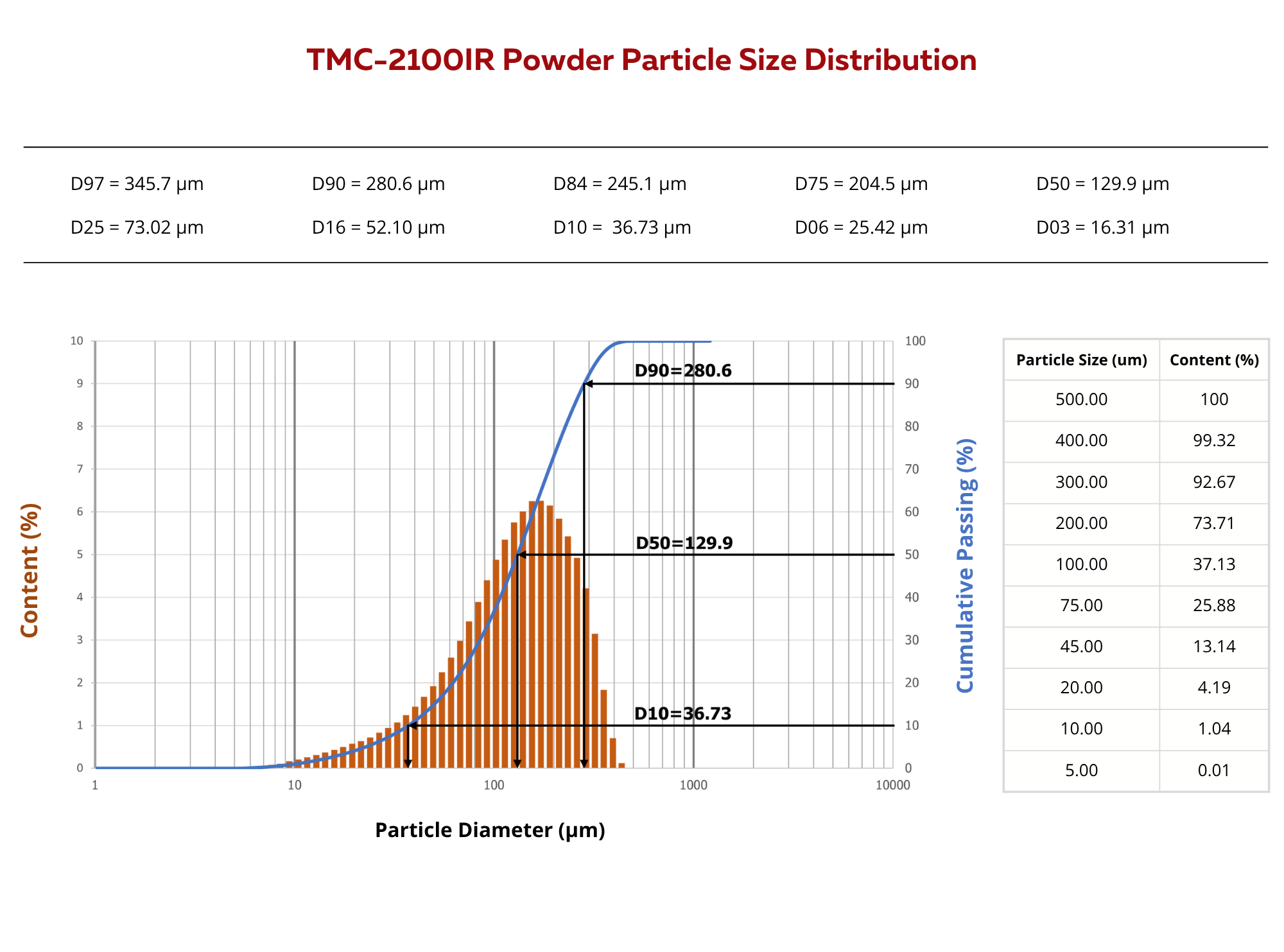OPTOLINQ TMC-2100IR | Transparent Molding Compound
- Low moisture absorption
- Superior moldability and reliability
- For IR Applications
Product Description
OPTOLINQ TMC-2100IR is a high-performance transparent epoxy molding compound. Engineered for precision IR applications, TMC-2100IR offers exceptional spiral flow, minimal moisture absorption, and superior moisture resistance. OPTOLINQ TMC-2100IR is formulated to achieve optimal moldability and long-term reliability optoelectronic components.
OPTOLINQ TMC-2100IR comes in different sizes to meet various mold design requirements. Contact us for custom sizes or other specific requirements.
Key Features
- High IR Transparency: Ensures superior infrared light transmission for optimal device performance.
- Low Moisture Absorption & Excellent Moisture Resistance: Effectively prevents moisture ingress, safeguarding long-term reliability.
- Reliable Under Harsh Conditions: Maintains consistent performance in environments with elevated temperature and humidity.
- High Adhesion & Low Stress: Provides strong, durable bonding with minimal internal stress, reducing risk of delamination or cracking.
Typical Applications
- Low-Power LED & Emitters
- Pulse Oximeter Sensors
- Ambient Light Sensors
- IR and Near-IR Sensors
- Data transmission and industrial fibers.
Versions Available
- Standard Low stress optical molding compound - TMC-2100
- Enhanced self-release, visible-pass with NIR filtering (>1100 nm) - TMC-2100H
- Superior IR optical transparency - TMC-2100IR
Alternative to: XX-8524 Series, XX-824H, XX-330H
Technical Specifications
| General Properties | |
| Specific Gravity Specific Gravity Specific gravity (SG) is the ratio of the density of a substance to the density of a reference substance; equivalently, it is the ratio of the mass of a substance to the mass of a reference substance for the same given volume. For liquids, the reference substance is almost always water (1), while for gases, it is air (1.18) at room temperature. Specific gravity is unitless. | 1.2-1.25 |
| Thermal Properties | |
| Glass Transition Temperature (Tg) Glass Transition Temperature (Tg) The glass transition temperature for organic adhesives is a temperature region where the polymers change from glassy and brittle to soft and rubbery. Increasing the temperature further continues the softening process as the viscosity drops too. Temperatures between the glass transition temperature and below the decomposition point of the adhesive are the best region for bonding. The glass-transition temperature Tg of a material characterizes the range of temperatures over which this glass transition occurs. | 110 °C |
| Mechanical Properties | |
| Molded Shrinkage | 1.5 % |
Additional Information
OPTOLINQ TMC-2100IR Additional Technical Specifications
| Property | Value | Unit |
| Transmittance at 400nm | >85 | % |
| Preheat Temperature | 75-95 | ℃ |
| Molding Temperature | 150-160 | ℃ |
| Molding Pressure | 3-8 | MPa |
| Post Cure Time @150℃ | 4 | hours |
OPTOLINQ TMC-2100 | Optically Clear Molding Compound
TMC-2100 is developed to exhibit robust optical performance, TMC-2100IR a high IR transparent version designed for applications operating above the visible light spectrum.
OPTOLINQ TMC-2100IR | Optically Clear Molding Compound
TMC-2100IR boasts its blended chemistry system to improve IR transparency through refractive index matching and IR-transparent fillers. The transmittance shown is measured at 2 mm thick sample and will exhibit higher transmittance at a thinner samples and packages.
 Inspected specimens are 1 mm thick sample cured in mold for 4 minutes at 150°C and post cured for 4 hours at 150°C.
Inspected specimens are 1 mm thick sample cured in mold for 4 minutes at 150°C and post cured for 4 hours at 150°C.  Inspected specimens are 2 mm thick sample cured in mold for 4 minutes at 150°C and post cured for 4 hours at 150°C.
Inspected specimens are 2 mm thick sample cured in mold for 4 minutes at 150°C and post cured for 4 hours at 150°C.
TMC-2100IR Particle Size Distribution: Powder for Compression Molding
OPTOLINQ TMC-2100IR Powder for Compression Molding
The particle-size distribution of TMC-2100IR coarse powder is tightly centred on a median diameter (D50) of 129.9 µm. Only 10 vol % of particles are finer than 36.7 µm (D10) and 90 vol % are below 280.6 µm (D90), giving a span of 1.88 that denotes a moderately narrow, well-graded curve.
Most particles fall between roughly 40 µm and 280 µm, supplying enough fines to fill interstices without dusty handling and few oversize granules that might entrap air during mould filling. The volume-average diameter D[4,3] of 145.5 µm confirms mass clustering near the median, while a specific surface area of 29.9 m²kg⁻¹ signals moderate binder demand. Because our process controls D50 within 80–160 µm, future lots will closely replicate this flow and packing behavior.
Got questions or need help selecting the right optical grade for your filter applications? Reach out to us!
Contact Us →
Directions Before Use
- Thaw TMC-2100IR to room temperature (20±5℃, 40±15%RH) at least 24 hours before use. Do not open the bag to avoid moisture contamination.
- Slowly preheat the molding compound using standard RF equipment.




